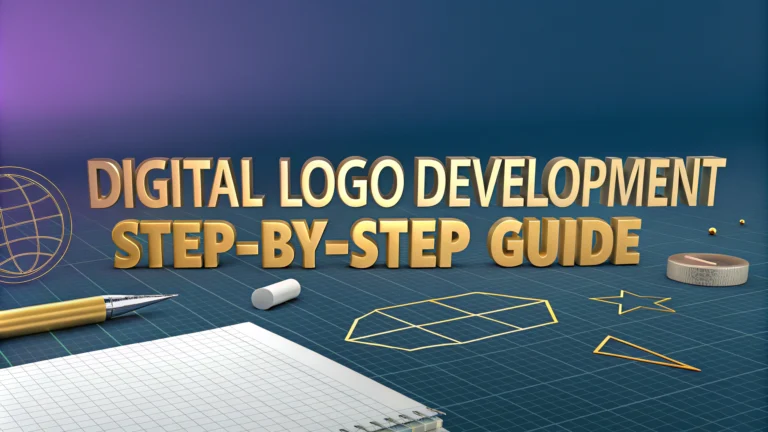A digital logo needs to meet specific technical requirements for professional use across different platforms and mediums.
Vector formats like AI, EPS, or SVG ensure your logo remains crisp at any size, unlike pixel-based formats like JPG or PNG.
Essential File Format Requirements
- Primary Vector File (AI or EPS)
- SVG for web use
- High-resolution PNG with transparent background
- JPEG for basic applications
- PDF for print materials
Color Specifications
- CMYK version for print materials
- RGB version for digital displays
- Pantone colors for brand consistency
- Black and white version
- Single-color variations
The minimum size requirement ensures your logo remains legible when scaled down for business cards or favicons.
Size Requirements
| Application | Minimum Size |
|---|---|
| 0.5 inches / 12.7mm | |
| Digital | 32px height |
| Favicon | 16x16px |
Technical Specifications
- Resolution: 300 DPI for print files
- Color Profile: Adobe RGB 1998 or sRGB
- Clear space: Logo height x 0.5 on all sides
- File naming: CompanyName_Logo_ColorMode_Size
A logo package should include both horizontal and vertical arrangements when applicable.
Common Issues to Avoid
- Raster-only files without vector source
- Missing color variations
- Fonts not converted to outlines
- Low-resolution files
- Improper color modes for intended use
Store your logo files in cloud storage with backup options for easy access and distribution.
Contact a professional logo designer through platforms like Behance (www.behance.net) or Dribbble (dribbble.com) for custom logo creation that meets these requirements.
Additional Technical Considerations
File Organization
- Create separate folders for web, print, and social media
- Include a brand guidelines PDF
- Maintain version control documentation
- Archive original source files securely
Social Media Requirements
| Platform | Profile Image Size |
|---|---|
| 400x400px | |
| 180x180px | |
| 400x400px |
Responsive Design Elements
- Simplified version for small screens
- Icon-only version for app icons
- Responsive scaling breakpoints
- Mobile-first considerations
Conclusion
Professional logo implementation requires attention to technical specifications across multiple formats and platforms. Maintaining proper file organization and adhering to format-specific requirements ensures consistent brand representation.
Regular audits of logo assets and updates to match evolving platform requirements help maintain professional brand presence. Invest in proper file preparation and storage to protect your brand’s visual identity.
Key Takeaways
- Always maintain vector source files
- Prepare format-specific versions
- Follow platform-specific requirements
- Implement proper file organization
- Maintain secure backups
FAQs
- What are the standard file formats required for a digital logo?
Vector formats (AI, EPS, SVG) for scalability, and raster formats (PNG, JPEG) for web use. AI and EPS are essential for print, while PNG with transparency is ideal for digital applications. - What color modes should my logo files include?
CMYK for print materials (300 DPI minimum), RGB for digital display, and Pantone (PMS) colors for brand consistency. All versions should be provided in the final logo package. - What’s the minimum size requirement for a logo to remain legible?
Logos should remain clear at 1 inch (72 pixels) for print and 32 pixels for digital favicon use. All elements must be distinguishable at these minimum sizes. - How many logo variations should be included in a standard logo package?
A complete package should include primary logo, secondary logo, icon/symbol only, horizontal and vertical layouts, and monochrome versions (black, white, and single color). - What resolution requirements are needed for different logo applications?
Print requires 300 DPI minimum, web usage needs 72 DPI, and large format printing may require 600 DPI or higher depending on the application. - Should my logo have a transparent background?
Yes, logos should be delivered with transparent backgrounds in PNG and AI/EPS formats to allow flexibility in placement over different backgrounds and materials. - What are the spacing requirements for logo protection?
A clear space (exclusion zone) of at least the height of a logo letter ‘X’ should surround the logo on all sides to maintain visual impact. - What’s the best way to ensure logo color consistency across platforms?
Include color codes for all formats: CMYK, RGB, HEX, and Pantone. Create a style guide with specific color values and usage guidelines. - How should logo files be organized and delivered?
Organize files in clearly labeled folders by format (Vector/Raster), color mode (CMYK/RGB), and usage type (Print/Web). Include a PDF guide explaining file usage. - What are the essential logo trademark and copyright requirements?
Include trademark symbols (™, ®) if registered, and provide usage rights documentation. Define permitted and restricted uses in the brand guidelines.








